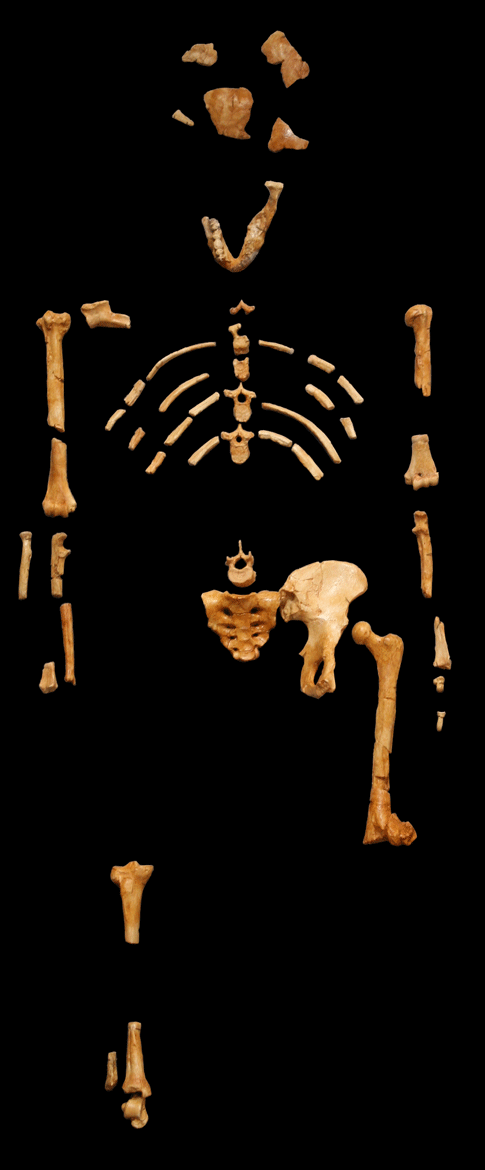


“Lucy” has fascinated scientists ever since her 3.2-million-year-old skeleton was found in Ethiopia over 40 years ago. The exquisite Australopithecus afarensis specimen, one of the oldest and most complete human relatives ever found, gave researchers a glimpse back into a time when diminutive hominids, no larger than modern kindergarteners, took the first upright steps toward modernity.
But whether Lucy and her ilk were seasoned walkers—descendants of species that had long since climbed down from the trees—or were still swinging around like more primitive primates has been a subject of fierce debate. Did Lucy spend most of her life in trees, or on the ground? A new study published Wednesday in PLOS ONE may not put this question to rest forever, but its authors hope their findings will help kill the acrimonious aspects of the debate once and for all.
“What our study hopefully shows is that, well, yeah, she definitely climbed trees,” says study author Christopher Ruff, a professor of functional anatomy and evolution at the Johns Hopkins University School of Medicine. “The almost visceral response to whether she was arboreal or not, there is a lot of history there. It got very polarized, I would say, and that kind of went on for awhile and then died down, but it’s kind of simmering under the surface.”
This schism came up recently when The University of Texas at Austin’s John Kappelman, who contributed to Ruff’s new study, published evidence that Lucy had died after falling from a tree. The study, while intriguing, relied on evidence of fractures that many paleontologists found circumstantial. But researchers didn’t just scoff at the woeful story Kappelman spun about Lucy’s death; some were viscerally opposed to the notion that she would have climbed a tree in the first place.
“The a priori assumption that Lucy spent much time in the trees is not supported,” Arizona State University’s Donald Johanson, part of the team that discovered Lucy, told The Washington Post in August.
The problem rests in Lucy’s bones: Her body shows morphological features somewhere between that of a modern chimp and a modern human. Her lower body seems well-suited for walking, but her trunk and limbs are peppered with primitive adaptations for climbing. Some scientists argue that Lucy’s chimp-like features are simply remnants from an ancestor, vestigial features she no longer used. The new study gets past this issue, using the latest in high-tech scanning to examine more minute morphological features in Lucy’s bones (which have long since turned to hard-to-study rock) and points out features that many researchers believe could only be acquired by actually climbing.
“We know these parameters are developmentally plastic,” Ruff says. “They change based on how you use your limb.” When humans are born, he says, the ratio of strength between their upper arm and upper leg bones is quite similar to the ratio seen in monkeys. “It’s only once you start walking that you develop a thigh bone relatively stronger than your upper arm bone,” he says. And people who put particular mechanical stress on a bone make it stronger—tennis players have been found to develop stronger bones on their dominant side.
Ruff’s latest examination of Lucy showed upper arm bones that were heavily built relative to her legs. To him, that’s a clear sign that she spent a good portion of her day hanging out in the branches.
“We certainly don’t think she was playing tennis,” he says. “The most likely explanation is that she was using trees in a significant way. You don’t get strong upper arm bones by doing a few pull-ups a week.”
He also noted signs in her hips that she walked with an inefficient, swaying gait, “so we don’t think she was a long-distance walker,” he says.
Some scientists may still argue that Ruff’s conclusions are unsound. Sergio Almécija of George Washington University, who wasn’t involved in the new study, points out that some research has failed to support the idea that mechanical use leads to changes in bone density. “But that’s another debate,” he says. For him, this and other research is enough evidence to support a more moderate view of Lucy’s tree climbing habits.
“I understand some primitive features would take time to disappear, but there are primitive features all over Lucy’s body,” Almécija says. “And there are populations of modern humans today who climb trees all the time when they need to forage. When you look at our bodies, we don’t look at all like we would be well-suited for climbing. So it’s hard for me to believe that Lucy didn’t climb at all.”
Modern students, Almécija says, tend to have this same moderate view. And without a time machine, he likes to tell his students, they can never really know for sure. But some scholars remain firmly in the no-tree camp.
“When they have said so many times in papers that Lucy was for sure fully terrestrial, after so many years they become trapped in their own words. It’s really hard to change your mind after a whole career,” he says.
Ruff hopes that this new data will make some scientists take another look. “I would just like people to look at the evidence and say it’s not all black and white,” he says. “It doesn’t mean she was like a chimp at all—she obviously wasn’t. But she wasn’t like us, either. Not exactly.”
